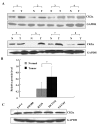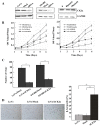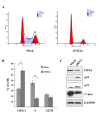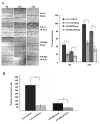Protein kinase CK2α is overexpressed in colorectal cancer and modulates cell proliferation and invasion via regulating EMT-related genes
- PMID: 21702981
- PMCID: PMC3132712
- DOI: 10.1186/1479-5876-9-97
Protein kinase CK2α is overexpressed in colorectal cancer and modulates cell proliferation and invasion via regulating EMT-related genes
Abstract
Background: Protein kinase CK2 is a highly conserved, ubiquitous protein serine/threonine kinase that phosphorylates many substrates and has a global role in numerous biological and pathological processes. Overexpression of the protein kinase CK2α subunit (CK2α) has been associated with the malignant transformation of several tissues, with not nearly as much focus on the role of CK2α in colorectal cancer (CRC). The aims of this study are to investigate the function and regulatory mechanism of CK2α in CRC development.
Methods: Expression levels of CK2α were analyzed in 144 patients (104 with CRC and 40 with colorectal adenoma) by immunohistochemistry. Proliferation, senescence, motility and invasion assays as well as immunofluorescence staining and western blots were performed to assess the effect of CK2α in CRC.
Results: The immunohistochemical expression of nuclear CK2α was stronger in tumor tissues than in adenomas and normal colorectal tissues. Suppression of CK2α by small-interfering RNA or the CK2α activity inhibitor emodin inhibited proliferation of CRC cells, caused G0/G1 phase arrest, induced cell senescence, elevated the expression of p53/p21 and decreased the expression of C-myc. We also found that knockdown of CK2α suppressed cell motility and invasion. Significantly, CK2α inhibition resulted in β-catenin transactivation, decreased the expression levels of vimentin and the transcription factors snail1 and smad2/3, and increased the expression of E-cadherin, suggesting that CK2α regulates the epithelial-mesenchymal transition (EMT) process in cancer cells.
Conclusions: Our results indicate that CK2α plays an essential role in the development of CRC, and inhibition of CK2α may serve as a promising therapeutic strategy for human CRC.
Figures






Similar articles
-
Protein kinase CK2 in breast cancer: the CK2β regulatory subunit takes center stage in epithelial plasticity.Cell Mol Life Sci. 2015 Sep;72(17):3305-22. doi: 10.1007/s00018-015-1929-8. Epub 2015 May 20. Cell Mol Life Sci. 2015. PMID: 25990538 Free PMC article. Review.
-
Reduced Proline-Rich Tyrosine Kinase 2 Promotes Tumor Metastasis by Activating Epithelial-Mesenchymal Transition in Colorectal Cancer.Dig Dis Sci. 2024 Nov;69(11):4098-4107. doi: 10.1007/s10620-024-08643-y. Epub 2024 Oct 16. Dig Dis Sci. 2024. PMID: 39414740
-
Loss of miR-638 in vitro promotes cell invasion and a mesenchymal-like transition by influencing SOX2 expression in colorectal carcinoma cells.Mol Cancer. 2014 May 23;13:118. doi: 10.1186/1476-4598-13-118. Mol Cancer. 2014. PMID: 24885288 Free PMC article.
-
Overexpression of nuclear protein kinase CK2 α catalytic subunit (CK2α) as a poor prognosticator in human colorectal cancer.PLoS One. 2011 Feb 17;6(2):e17193. doi: 10.1371/journal.pone.0017193. PLoS One. 2011. PMID: 21359197 Free PMC article.
-
Cadherins down-regulation: towards a better understanding of their relevance in colorectal cancer.Histol Histopathol. 2020 Dec;35(12):1391-1402. doi: 10.14670/HH-18-236. Epub 2020 Jun 22. Histol Histopathol. 2020. PMID: 32567668 Review.
Cited by
-
Green Synthesis and Anticancer Potential of 1,4-Dihydropyridines-Based Triazole Derivatives: In Silico and In Vitro Study.Life (Basel). 2022 Mar 31;12(4):519. doi: 10.3390/life12040519. Life (Basel). 2022. PMID: 35455010 Free PMC article.
-
lncSNHG3 drives breast cancer progression by epigenetically increasing CSNK2A1 expression level.Aging (Albany NY). 2023 Jun 21;15(12):5734-5750. doi: 10.18632/aging.204824. Epub 2023 Jun 21. Aging (Albany NY). 2023. PMID: 37348024 Free PMC article.
-
Emodin suppresses proliferation, migration and invasion in ovarian cancer cells by down regulating ILK in vitro and in vivo.Onco Targets Ther. 2017 Jul 19;10:3579-3589. doi: 10.2147/OTT.S138217. eCollection 2017. Onco Targets Ther. 2017. Retraction in: Onco Targets Ther. 2022 Aug 10;15:851-852. doi: 10.2147/OTT.S385443. PMID: 28790850 Free PMC article. Retracted.
-
Protein kinase CK2 in breast cancer: the CK2β regulatory subunit takes center stage in epithelial plasticity.Cell Mol Life Sci. 2015 Sep;72(17):3305-22. doi: 10.1007/s00018-015-1929-8. Epub 2015 May 20. Cell Mol Life Sci. 2015. PMID: 25990538 Free PMC article. Review.
-
A Humanized Yeast Phenomic Model of Deoxycytidine Kinase to Predict Genetic Buffering of Nucleoside Analog Cytotoxicity.Genes (Basel). 2019 Sep 30;10(10):770. doi: 10.3390/genes10100770. Genes (Basel). 2019. PMID: 31575041 Free PMC article.
References
Publication types
MeSH terms
Substances
LinkOut - more resources
Full Text Sources
Medical
Research Materials
Miscellaneous

